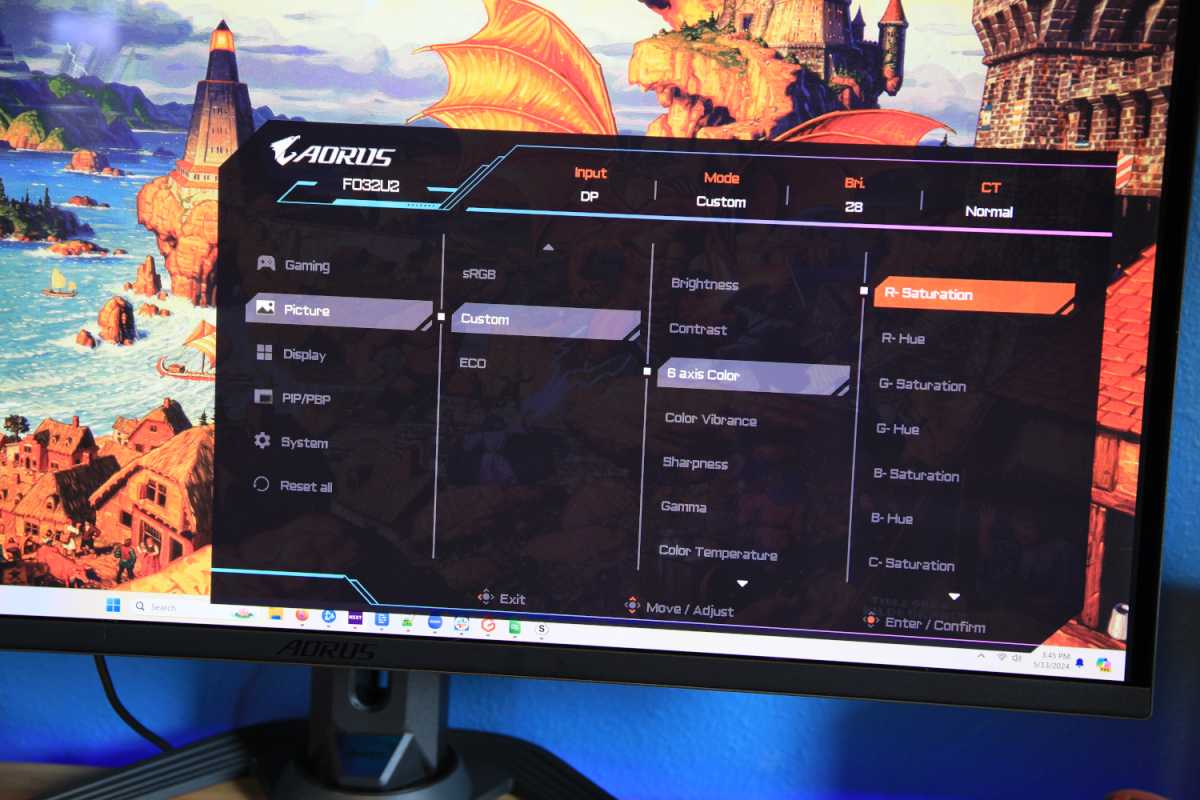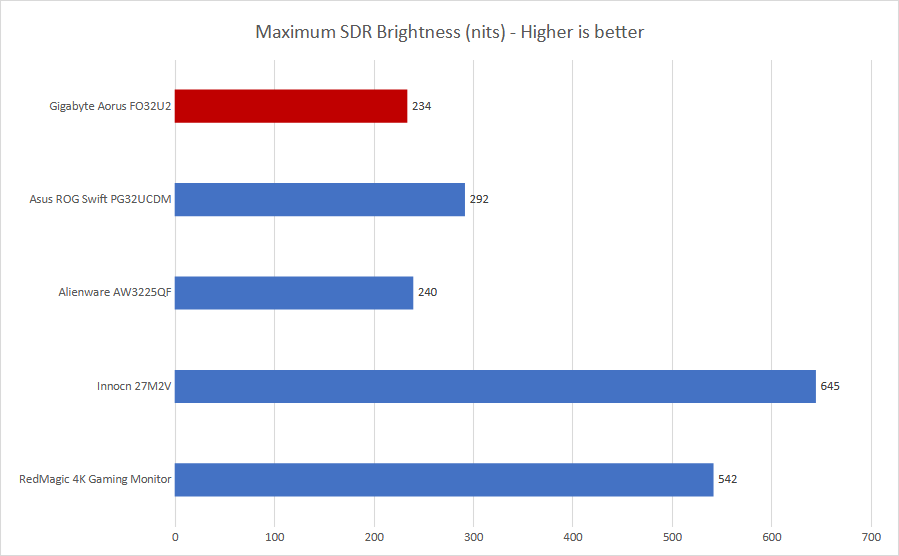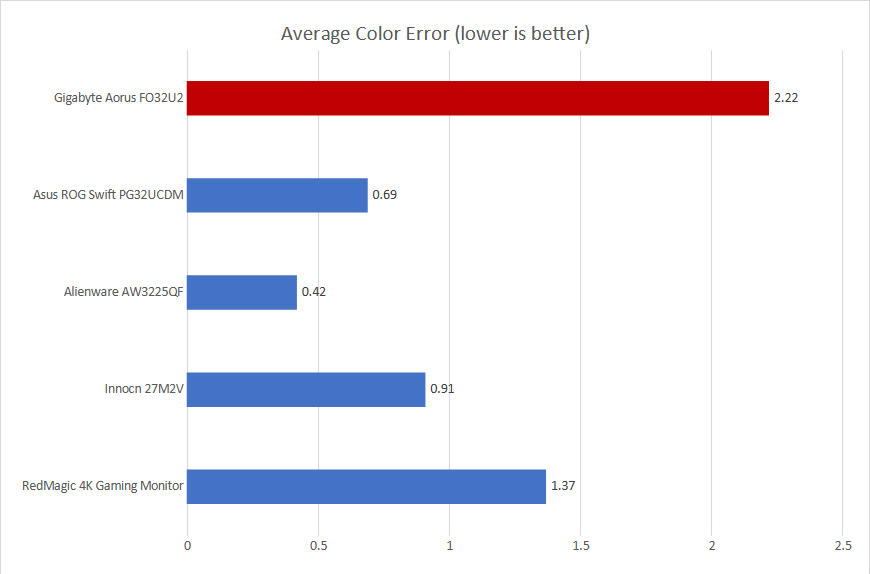Gigabyte Aorus FO32U2 review: Another beautiful OLED monitor, for better or worse
- Excellent image with immersive contrast
- Top-notch motion clarity
- Robust, sturdy build quality
- USB-C connectivity is available
- Design doesn’t stand out
- Stand is larger than it needs to be
- USB-C only provides 18 watts of Power Delivery
- Image quality is indentical to many competitors
Gigabyte’s Aorus FO32U2 is a superb 32-inch gaming monitor, but it struggles to push past competitors that use the same 4K QD-OLED display panel.
Price When Reviewed$1,099.99
Best Prices Today: Gigabyte Auros FO32U2 Retailer Price $1082.23
View Deal
$1082.23
View Deal
 $1099.99
View Deal
$1099.99
View Deal
 $1,165.99
View Deal
Price comparison from over 24,000 stores worldwide
Product
Price
Price comparison from Backmarket
$1,165.99
View Deal
Price comparison from over 24,000 stores worldwide
Product
Price
Price comparison from Backmarket
Gamers looking for an OLED monitor in 2024 have a staggering amount of choice with many brands now offering multiple OLED monitors. Gigabyte enters this suddenly packed arena with a new 32-inch 4K QD-OLED monitor that is in many ways similar to its competition. It’s an excellent display by nearly every measure but your purchasing decision will ultimately come down to the price.
Gigabyte Aorus FO32U2 specs & featuresThe Gigabyte Aorus FO32U2’s specifications are extremely similar to its competitors. It features a 4K QD-OLED display panel with a maximum refresh rate of 240Hz. It supports Adaptive Sync with AMD FreeSync Premium Pro certification and supports HDR with VESA DisplayHDR 400 True Black certification.
- Display size: 32-inch widescreen
- Native resolution: 3840×2160
- Panel type: Quantum Dot OLED
- Refresh rate: Up to 240Hz
- Adaptive sync: AMD FreeSync Premium Pro
- HDR: Yes, VESA DisplayHDR True Black 400
- Ports: 2x HDMI 2.1, 1x DisplayPort 1.4, 1x USB-C upstream with 18 watts Power Delivery and DisplayPort Alternate Mode, 1x USB-B upstream 2x USB-A downstream, 1x headphone jack, 1x microphone jack
- VESA mount: 100x100mm
- Speakers: 2x 5-watt speakers
- Price: $1099.99 MSRP
Gigabyte has made a few tweaks to the monitor’s features to help it stand out from the crowd. It includes a pair of 5-watt speakers, while many competitors have either less powerful speakers or none. The monitor also includes a USB-C port with DisplayPort Alternate Mode and 18 watts of power delivery. This is a feature that not all competitors have, and will make the monitor a bit easier to connect to modern laptops.
Further reading: See our roundup of the best gaming monitors to learn about competing products.
Gigabyte Aorus FO32U2 designThe Gigabyte Aorus FO32U2 doesn’t make the best impression out of the box. The monitor’s simple design combines a thin display panel with a thicker housing that occupies the center of the monitor’s rear, which contains the electronics and ports. It’s rather plain, at least next to competitors from Alienware and Samsung. That leaves the included RGB-LED lighting to do a lot of heavy lifting for the design, as nothing else stands out at a glance.
 The back of the Gigabyte Aorus FO32U2.
The back of the Gigabyte Aorus FO32U2.
 The back of the Gigabyte Aorus FO32U2.
The back of the Gigabyte Aorus FO32U2.Matthew Smith / Foundry
 The back of the Gigabyte Aorus FO32U2.
The back of the Gigabyte Aorus FO32U2.Matthew Smith / Foundry
Matthew Smith / Foundry
While the monitor’s looks aren’t much to talk about, Gigabyte uses quality materials with a pleasant texture throughout the display panel and the stand. There’s exceptionally little flex when handling the monitor, and the hefty stand base keeps it planted on a desk. The Aorus FO32U2 might not look as premium as its competitors, but don’t let that deceive you — it’s solid.
An ergonomically adjustable stand is included and attaches to the monitor through a 100x100mm VESA mount. It adjusts for height, tilt, swivel, and pivots 90 degrees for use in portrait orientation.
Unfortunately, Gigabyte opts for a wide stand design which occupies a lot of space on a desk. The stand legs aren’t flat, either, so it’s more difficult to use the space it occupies for other purposes. This is a problem shared with many of Gigabyte’s competitors, but there are a few alternatives, like the MSI MAG 321UPX and LG UltraGear 32GS95UE-B, with a flat stand.
A pair of decent built-in 5-watt speakers are a handy extra for gamers who usually rely on a headset but occasionally want to take a break from it.
 The Gigabyte Aorus FO32U2’s stand makes its presence known on a desk.
The Gigabyte Aorus FO32U2’s stand makes its presence known on a desk.
 The Gigabyte Aorus FO32U2’s stand makes its presence known on a desk.
The Gigabyte Aorus FO32U2’s stand makes its presence known on a desk.Matthew Smith / Foundry
 The Gigabyte Aorus FO32U2’s stand makes its presence known on a desk.
The Gigabyte Aorus FO32U2’s stand makes its presence known on a desk.Matthew Smith / Foundry
Matthew Smith / Foundry
Gigabyte Aorus FO32U2 connectivity and menusGigabyte uses connectivity to gain a bit of an edge over its competitors. The monitor has two HDMI 2.1 ports and one DisplayPort 1.4, which is typical for most high-end gaming displays. However, it also has a USB-C port with DisplayPort and 18 watts of USB Power Delivery. That brings the total video inputs to four, and the USB-C port is convenient when connecting and disconnecting a USB-C compatible laptop.
The USB-C port also connects to two downstream USB-A ports, allowing the monitor to act as a USB hub. Its connectivity is still limited compared to an office monitor like the Dell UltraSharp, but it’s better than what most gaming monitors offer. Asus’ ROG Swift PG32UCDM is one exception to this, however, as it also has a USB-C port, and delivers up to 90 watts of USB Power Delivery.
A joystick control on the middle lower bezel is used to access the on-screen menus. Gigabyte’s menus have an intuitive layout, are well-labeled, and use large fonts, all of which makes menu options easy to access and read. Gigabyte also offers a software control center that owners can download from the company’s website, providing access to many monitor settings.

The Gigabyte Aorus FO32U
2’s menu system is intuitive and easy to use.
The Gigabyte Aorus FO32U
2’s menu system is intuitive and easy to use.Matthew Smith / Foundry

The Gigabyte Aorus FO32U
2’s menu system is intuitive and easy to use.Matthew Smith / Foundry
Matthew Smith / Foundry
The monitor’s image quality settings are extensive. They include six-axis color calibration, five gamma presets (all targeting a specific gamma curve), and several color temperature presets (which do not target specific color temperature values). This is an excellent range of image quality options for a gaming monitor.
Gigabyte also provides a number of features that target gamers specifically. This includes a black equalizer feature that elevates the darkness of dark areas of the display to reveal foes who might be hiding. There’s also a “Display Mode” setting that can be used to change the aspect ratio and usable display size of the monitor. If you want to effectively turn the monitor into a 1920×1080, 24-inch display to maximize frame rates in highly competitive games, that’s an option.
The monitor also packs a pair of 5-watt speakers that deliver usable, if not impressive, audio quality. Their volume is enough to be useful in a quiet room, and they offer a decent soundstage with some sense of depth and good clarity across the mid-range. While a halfway decent pair of external speakers will still be an upgrade, they will prove handy for gamers who usually rely on a headset but occasionally want to take a break from it.
Gigabyte Aorus FO32U2 SDR image qualityImage quality is crucial for gaming monitors, and the Gigabyte Aorus FO32U2 excels in this area, delivering high marks across all metrics. However, its performance is nearly identical to other monitors that use Samsung’s latest QD-OLED panels.


Matthew Smith / Foundry

Matthew Smith / Foundry
Matthew Smith / Foundry
SDR brightness is a weak spot for the Aorus FO32U2, as is true for most OLED gaming monitors. We recorded a maximum brightness of 234 nits, which is comparable to other OLED monitors but much lower than a traditional LCD monitor or a monitor with a mini-LED backlight, such as the Innocn 27M2V.
It’s worth noting that the Aorus has a glossy display coating, too, so glare can be an issue if you don’t have good light control in the room where you intend to use the monitor.


Matthew Smith / Foundry

Matthew Smith / Foundry
Matthew Smith / Foundry
Contrast, on the other hand, is undeniably a strength, as the Aorus FO32U2 has an effectively infinite contrast ratio. In our testing, it achieves this by reaching a perfect minimum luminance of zero nits, which means dark and shadowy scenes look exactly as deep and immersive as they should. OLED monitors like the Aorus tend to provide a sense of realism and depth that isn’t available from most LCD monitors, although some with a Mini-LED backlight can come close.
However, while the Aorus performs well in contrast, it isn’t different from its competitors. All of the OLED monitors we’ve recently tested have delivered excellent contrast.


Matthew Smith / Foundry

Matthew Smith / Foundry
Matthew Smith / Foundry
Color gamut once again shows just how similar monitors from different brands can be when they use the same display panel. All three of the OLED monitors included in this comparison reached identical color gamut results. Fortunately, those results are quite good, spanning the entire sRGB color gamut as well as 98 percent of DCI-P3 and 94 percent of Adobe RGB.
That’s certainly more than enough to handle nearly anything that would be thrown at a modern monitor. But some monitors that use quantum dots and a Mini-LED backlight, such as the Innocn 27M2V and RedMagic 4K Gaming Monitor, can deliver an even wider color gamut, and they do so at a lower price.


Matthew Smith / Foundry

Matthew Smith / Foundry
Matthew Smith / Foundry
The Aorus FO32U2’s color accuracy requires some explanation. OLED monitors tend to slightly alter luminance as scenes change, which can cause problems for color accuracy measurements because the test patterns used are not shown at the appropriate level of brightness. Because of this, the Aorus FO32U2’s test score is worse than it appears when actually using the monitor. I don’t think owners will see anything wrong with the FO32U2’s color accuracy in real-world use.
But why, then, does it fall behind the Asus and Alienware QD-OLED monitors? The answer is in firmware. Asus has a uniform brightness mode setting specifically meant to prevent fluctuations in brightness, and Alienware’s default firmware seems to better control luminance out of the box. In practice, the Gigabyte, Asus, and Alienware have similar color accuracy.
The Aorus FO32U2 posted good results in gamma and color temperature. The gamma curve hit our preferred target of 2.2, and color temperature came in at 6400K, which is just slightly warmer than our preference of 6500K. Both of these figures can be adjusted with the monitor’s settings, so you can tailor them to your preference.
Sharpness is a perk, as the monitor’s 4K resolution translates to about 137 pixels per inch, which is high enough to provide a tack-sharp look on the Windows desktop and in modern 3D games. The new QD-OLED panel, combined with the monitor’s high resolution, banishes the subpixel issues of last year’s 1440p OLED monitors, which caused a grainy look in some situations.
In summary, the Gigabyte Aorus FO32U2’s image quality is fantastic and has few downsides. We would prefer to see higher brightness, but that’s a flaw shared with other OLED monitors. The excellent contrast ratio, combined with the wide color gamut, provides an immersive and vivid image that really pops off the screen. The Aorus FO32U2 doesn’t have any advantage over competitors like the Alienware and Asus OLED monitors, but it still looks great and far outperforms most LCD displays.
Gigabyte Aorus FO32U2 HDR image qualityHDR can prove a challenge for OLED gaming monitors, at least when compared to Mini-LED alternatives, and the Gigabyte Aorus FO32U2 is no exception. Though its HDR performance is likely acceptable for most gamers, it falls behind Mini-LED.
I recorded a maximum full-screen HDR brightness of only 250 nits, which is typical for OLED monitors. However, when only 10 percent of the display surface was lit, the maximum HDR brightness jumped dramatically to 437 nits. That’s still not a lot, but it’s high enough that the added HDR brightness starts to become noticeable and reveals more detail.
The monitor’s HDR performance is best in dark scenes with bright highlights, like a starlit sky or a poorly lit alleyway lit by bright neon signs. It’s less impressive when displaying a large, sheer bright image like a snowy mountainside. Shoppers should think about the type of content they want to view on the monitor and how the monitor’s performance does, or doesn’t, fit.
Mini-LED monitors, which can often achieve a maximum brightness in excess of 1,000 nits, tend to be more impressive in HDR content. Still, the Gigabyte Aorus FO32U2 will deliver a huge upgrade for gamers moving up from an older LCD monitor.
Gigabyte Aorus FO32U2 motion performanceMotion clarity is among the Gigabyte Aorus FO32U2’s best traits. The monitor has a maximum refresh rate of 240Hz, which provides excellent motion fluidity, and this is combined with a low pixel response time of as little as 0.3 milliseconds. A lower pixel response time means less blur, and when combined with the refresh rate, it produces an extremely crisp image that is competitive with, or better than, LCD monitors that have a 360Hz refresh rate.
The monitor also has AMD FreeSync Premium Pro certification, which means that it can sync up with the output frame rate from your video card to eliminate screen tearing and reduce stutters. While Gigabyte does not have Nvidia certification, the monitor should be G-Sync compatible and should also work with other devices that have Adaptive Sync capability.
Once again, the Aorus FO32U2 is hampered by the fact other QD-OLED monitors offer essentially the same results. Gigabyte has no advantage over competitors from Alienware, Asus, and other brands. Still, motion clarity is extremely impressive.
Should you buy the Gigabyte Aorus FO32U2?The Gigabyte Aorus FO32U2 is an excellent monitor. In fact, if it were the only OLED monitor released in 2024, it would probably be the best gaming monitor of the year. The problem, of course, is that it’s not the only OLED gaming monitor released this year, and Gigabyte faces many competitors that offer similar performance.
The Alienware AW3225QF offers a more attractive design, and the Asus ROG Swift PG32UCDM offers official G-Sync support and a USB port with a higher maximum power delivery of 90 watts. As a result, the Aorus FO32U2 is not my top pick for a 32-inch 4K OLED monitor. However, if you see it on sale for slightly less than the Alienware or Asus, and you don’t care about the advantages those monitors have, the Aorus FO32U2 is a good alternative
Monitors